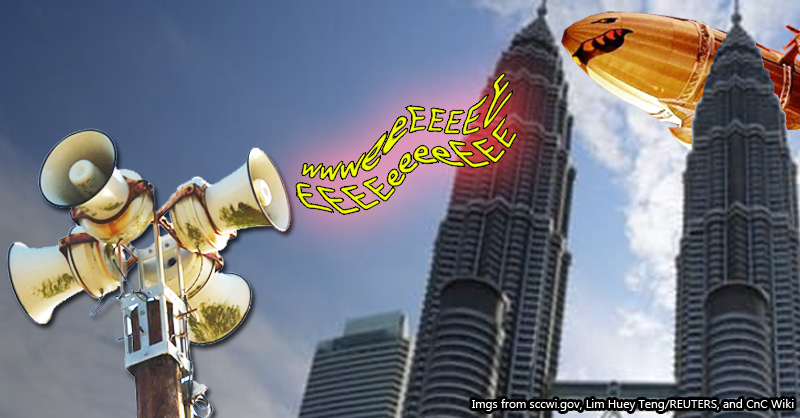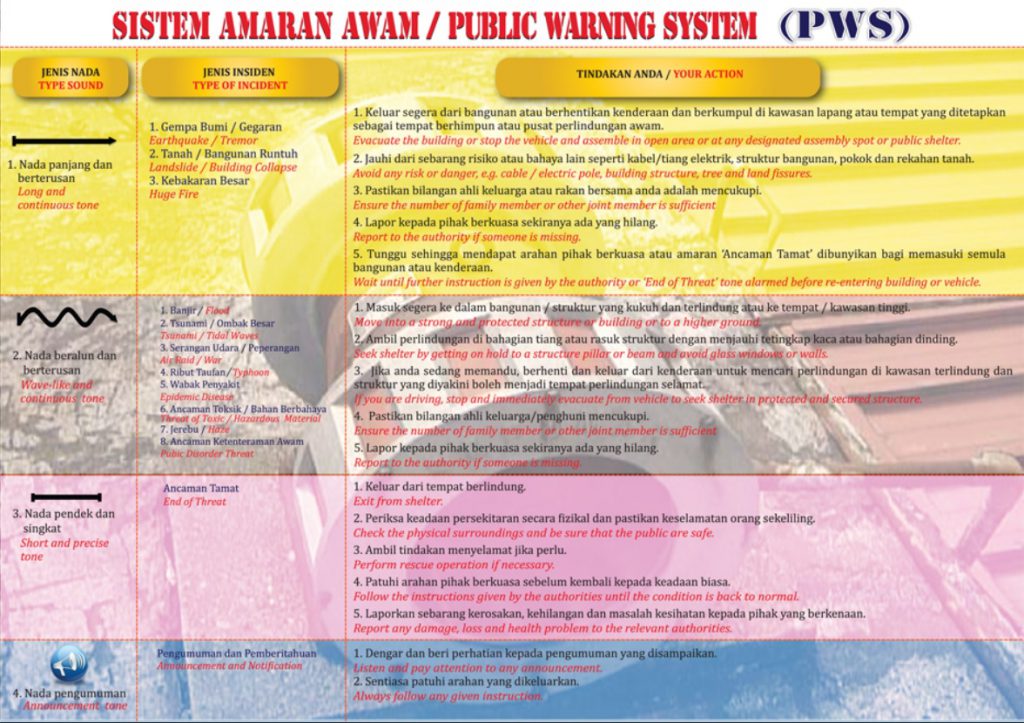Malaysia has a siren system for practically every disaster… including air raids.

- 313Shares
- Facebook276
- Twitter10
- LinkedIn7
- Email11
- WhatsApp9
With the Russian – Ukraine conflict happening, you might have seen some videos of air raid sirens over empty Ukrainian cities like this one.
This got us thinking… do we have a similar thing in Malaysia?
Redditor u/CapableBank_4151 had recently written a comprehensive series of posts about the warning sirens we have in Malaysia, and perhaps surprisingly, one of them is air raid sirens. Apparently, we do have a system to warn against air raids, and essentially…
Our air raid sirens sound like flood sirens
In theory, anyways. We’ve personally never heard one. According to information from the MyGovernment portal, we’ve had a warning system for possible air strikes since 1952, when the British first brought it in. Called the Public Warning System (PWS), it was handled by the Civil Defence Force, which many people know as JPAM (now APM). The PWS is basically a system of sirens installed at important locations, such as ports, town centers, and high population areas.
Although it started out as a warning system against air strikes, the function had since been expanded to include warnings about disasters like landslides and floods as well during times of peace. As for what it sounds like, generally there’s only two kinds of tones you have to remember: a long, continuous single tone, and a wavy sort of tone.

The chart seems like a lot at first, but from what we can surmise, the long tone is a warning for disasters where you need to get out of buildings and into open space, like earthquakes, landslides, collapsing buildings, and fires, and it sounds something like this:
On the other hand, the wavy tone is to warn against potential disasters where you need to take shelter in a strong building or higher ground, depending on what kind of disaster it is: floods, tsunamis, typhoons, diseases, haze, toxic/hazardous threats, and during times of war, air strikes. While we haven’t found a video of the APM testing this tone out, it should sound something similar to this:
There’s also the short tone that indicates the crisis is over as well as verbal announcements, but those are pretty intuitive. However, as u/CapableBank_4151 had observed, it seems that these APM sirens are all manually operated, so there might be a slight delay from when the crisis is made apparent to the actual warning, as APM members receive the command and rush to activate the sirens.
With that in mind, you might be wondering…
Will the air raid sirens be as reliable as our flood sirens?
Our experience in last year’s central region floods showed that some flood sirens allegedly did not work when it mattered, possibly due to a lack of maintenance and/or irresponsible people stealing parts from those sirens.
However, it’s worth noting that there are other bodies than APM handling warning systems in Malaysia: the Department of Irrigation and Drainage (JPS) is the one handling the National Flood Forecasting and Warning Program (PRAB), and the Meteorological Department (MetMalaysia) is the one handling the tsunami sirens, which is perhaps why they sound a bit different:
Unlike flood and tsunami sirens, which are dotted in high-risk areas, APM’s sirens seem to be either mounted on a tower within their bases or be in the form of mobile sirens to be rolled out during disasters, so they should be relatively-tamper proof. The video of the APM above also seems relatively recent (in 2021), and the video description implies that they hold simulations to educate the public to recognize the warning sirens. So we can assume that the sirens are maintained regularly as well. Based on these reasons, we can expect our air raid alarms to be functional if there ever was an air raid (touch wood).
So what do you do if you hear such a siren during war? Well, while we’re not sure if Malaysia had built air raid shelters we can head to, the WHO had published a sort of guide which you can find here. Essentially:
- take shelter underground if possible (basements, underground parking, etc) or the lowest part of a building
- stay away from windows, glass, or anything that might break in a blast and cause serious injury
- if you can’t stay away from windows, put masking tape or a plastic sheet over them
- shelter near a solid wall or pillar, but don’t touch or lean into them as you can get injured by their sudden movement
- if you’re caught outside, find a depression in the ground (like a ditch or something) and lie flat on your face to evade shrapnel
- cover exposed skin with non-flammable materials
- don’t go out and take a video of the air raid or something
Hopefully, we’ll never have to remember these, but you never know.
- 313Shares
- Facebook276
- Twitter10
- LinkedIn7
- Email11
- WhatsApp9
